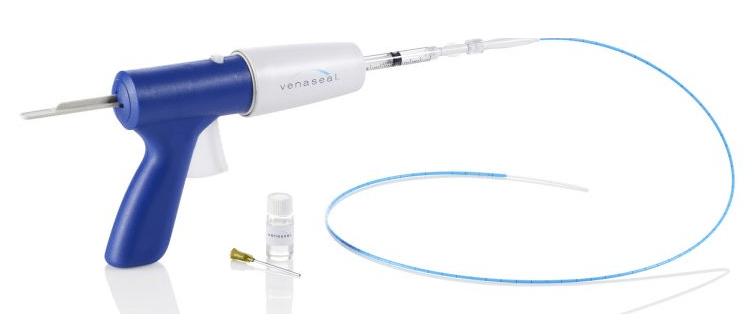
VenaSeal is the absolute latest innovation available to treat varicose veins
The VenaSeal closure system is the only non-tumescent, non-thermal, non-sclerosant procedure that uses a proprietary medical adhesive delivered endovenously to close the vein. This unique approach eliminates the risk of nerve injury when treating the small saphenous vein, which is a risk sometimes associated with certain thermal-based procedures.1,2 Clinical studies have demonstrated that the procedure is safe and effective.1-4 The procedure is administered without the use of tumescent anesthesia, avoiding patient discomfort associated with multiple needle sticks.
What To Expect
Before the VenaSeal™ Closure Procedure:
You will have an ultrasound imaging exam of the leg that is to be treated. This exam is important for assessing the diseased superficial vein and planning the procedure.
During the Procedure:
Your doctor can discuss the procedure with you. A brief summary of what to expect is below:
•You may feel some minor pain or stinging with a needle stick to numb the site where the doctor will access your vein.
•Once the area is numb, your doctor will insert the catheter (i.e., a small hollow tube) into your leg. You may feel some pressure from the placement of the catheter.
•The catheter will be placed in specific areas along the diseased vein to deliver small amounts of the medical adhesive. You may feel some mild sensation of pulling or tugging. Ultrasound will be used during the procedure to guide and position the catheter.
•After treatment, the catheter is removed and a bandage placed over the puncture site.
After the Procedure:
You will be taken to the recovery area to rest. Your doctor will discuss with you what observations will be performed following treatment.
Potential Risks:
The VenaSeal procedure is minimally invasive and catheter-based. As such, it may involve the following risks. Your doctor can help you understand these risks.
- Allergic reaction to the VenaSeal adhesive
- Arteriovenous fistula (i.e., an abnormal connection between an artery and a vein)
- Bleeding from the access site
- Deep vein thrombosis (i.e., blood clot in the deep vein system)
- Edema (i.e., swelling) in the treated leg
- Hematoma (i.e., the collection of blood outside of a vessel)
- Hyperpigmentation (i.e., darkening of the skin)
- Infection at the access site
- Neurological deficits including stroke and death
- Non-specific mild inflammation of the cutaneous and subcutaneous tissue
- Pain
- Paresthesia (i.e., a feeling of tingling, pricking, numbness or burning)
- Phlebitis (i.e., inflammation of a vein)
- Pulmonary embolism (i.e., blockage of an artery in the lungs)
- Urticaria (i.e., hives) or ulceration may occur at the site of injection
- Vascular rupture and perforation
- Visible scarring
